Neymar and Barcelona are a love story of old and while we wait for yet another transfer saga to be resolved, the question remains: Do the Catalans need their Brazilian superstar back and would he solve their problems?
This tactical analysis will be a scout report on Neymar and will delve deeper into the analysis of whether he would fit Barcelona’s current tactics. We will explore his change in profile, compare him to some of the players who occupied his position in his absence and see whether having a “second Lionel Messi” could work for the Blaugranas.
Let’s dive straight into it.
The evolution of Neymar
Neymar left Barcelona right before he was about to enter his peak years and evolve further into a complete attacking player. But years have passed since he last donned the Blaugrana colours and Barcelona would indeed be getting a completely different player to the one we saw back in 2016/17 and the years before that.
Back when the deadly “MSN” trio still harassed the defences, the Brazilian was very much a direct type of a winger and more of a traditional one at that. He possessed a dose of pace, which he still does, hugged the touchline and was used to quickly and effectively create an advantage out wide and burst into the space behind the opposition’s defensive line.
And while today he arguably does even more damage than he used to do back then, he does it in a completely different way. Let’s explore that a bit further in the graph you can see below where we have compared Neymar’s last season at Barcelona to his current 2019/20 self at Paris Saint-Germain.
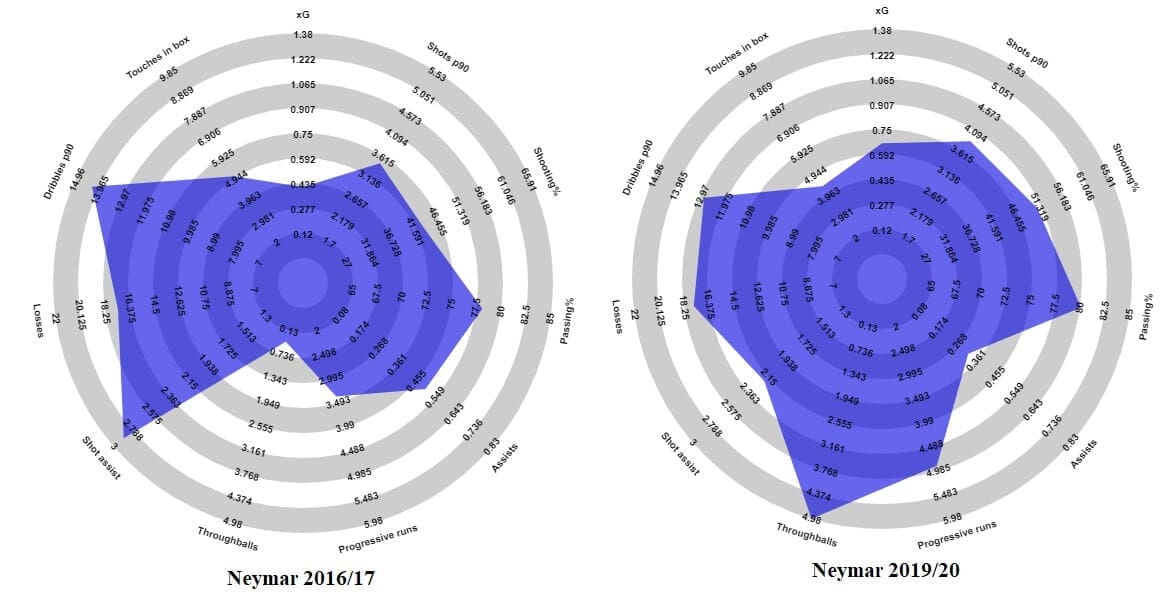
The radars depict his evolution over the years and show the aspects of his game that have improved drastically as well as those that have taken a slight dip as a direct consequence of that. It has to be noted, however, that both the 2016/17 and the 2019/20 profiles were compared to the maximum value across the top five leagues in the respective metrics that were measured. So essentially, both radars are a depiction of Neymar vs the best of the best in those specific stats.
Interestingly enough, the biggest difference between the two is the huge upgrade in his creativity and progression of the ball. Notice how both his through balls and progressive runs have improved dramatically as the result of the change in his main role.
Back in 2016/17, Neymar was a huge threat down the flanks and with the sheer attacking output between him, Messi and Luis Suárez, his assist tally skyrocketed despite him not being in a highly creative role at that time.
But now, even without the Argentine and the Uruguayan, he can still boast an incredible assists per 90 minutes rate – with a marginal dip in both that category and the shot assist one. But the rest of his profile looks far more impressive. Not only does he shoot more often and is much more precise but he is a much better passer and his xG values have risen as well. But two more metrics that have taken a hit are his touches in the box and dribbles per 90 minutes. The former is closely related to his general positioning on the pitch.
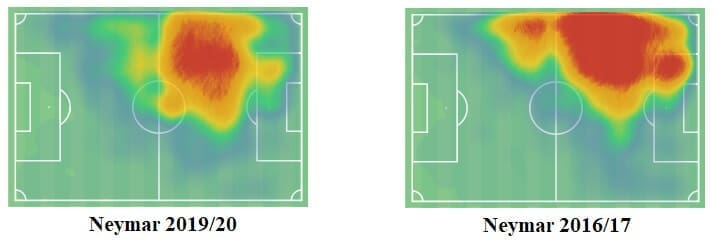
Notice in the heatmaps below how his movement and positioning has evolved over the years. While in 2016/17 he was a much bigger presence in the advanced areas, often occupying the flanks in the final third and even the area inside the box, now he tends to advance through the centre a bit more.
The added caveat is that he hasn’t played the same number of games in both cases with 2019/20 campaign being much shorter both due to his personal absences and the recent outbreak, which is true both for the heatmap and the stats he’s accumulated.
At Barcelona, we wouldn’t see him in such a deep role unless he was advancing the ball through a quick transition or trying to dribble his way from his half. Now, at PSG in Ligue 1, we’re used to him being the one to orchestrate play and be the creative outlet that isn’t afraid to position himself behind the forward line.
Notice in the image below how Neymar isn’t the one to run into space behind the defensive line but is rather the one sending that through ball to penetrate the block and set up his teammate.
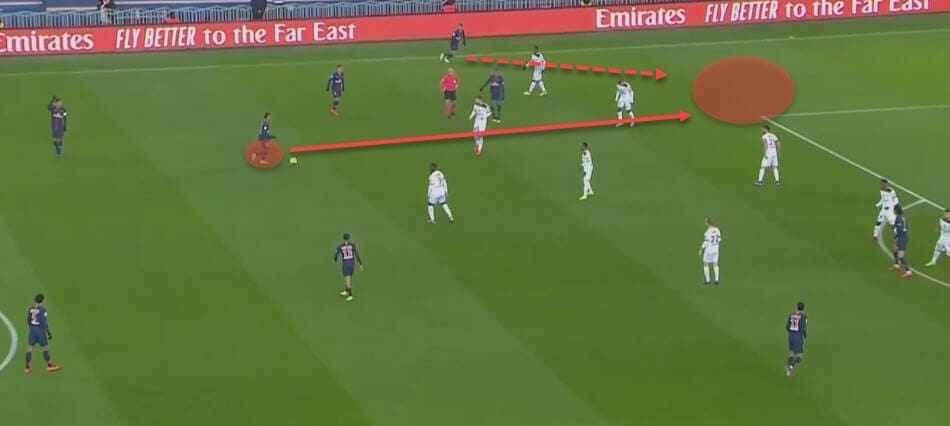
The new Neymar is still flamboyant, deadly and indeed a trickster on the ball but he is also the creator and the finisher, an orchestrator and a deep playmaker when he needs to be. Does that remind you of anyone else in this Barcelona squad?
Neymar vs Barcelona’s previous wingers
In the gist of it, this comparison is rather unfair towards Philippe Coutinho and Antoine Griezmann in many ways but the reality of the situation is that they were, despite the previous narrative that the former would replace Andrés Iniesta and the latter Suárez, used as the players who would often fill Neymar’s vacant position on the left-wing.
Coutinho is more of an interior himself; a player who thrives when given enough freedom around the edge of the area and just behind the striker in that number 10 role. Griezmann works best as the second-striker but equally enjoys freedom across the final third and in and around the box.
Let’s first compare their heatmaps to see how their roles differ one from another. Clearly, Griezmann’s heatmap is entirely different because he was partly used as a left-winger and partly as a centre-forward but we only need his involvement in the wide areas for a successful comparison.

While generally speaking the maps of Neymar and Coutinho do look fairly similar, the former seems to cover slightly more ground than the latter, meaning that he’s freer in his role. This could be down to: a) The system he played in or b) Player’s preferences on the pitch.
We can also see that for a winger, Coutinho rarely advanced into the opposition’s box and the wide area just outside it. Instead, he would cut inside to his half-space, the area both players seem to prefer. The same is true for Griezmann as well who would still prefer to cut inside instead of advance further down the wing and provide width to the team.
But there’s a glaring difference in their overall output for their respective clubs. Note that we are taking Coutinho’s last season at Barcelona for the profile comparison and Griezmann’s current 2019/20. All three are compared to the best value across the top five leagues in the ongoing campaign.
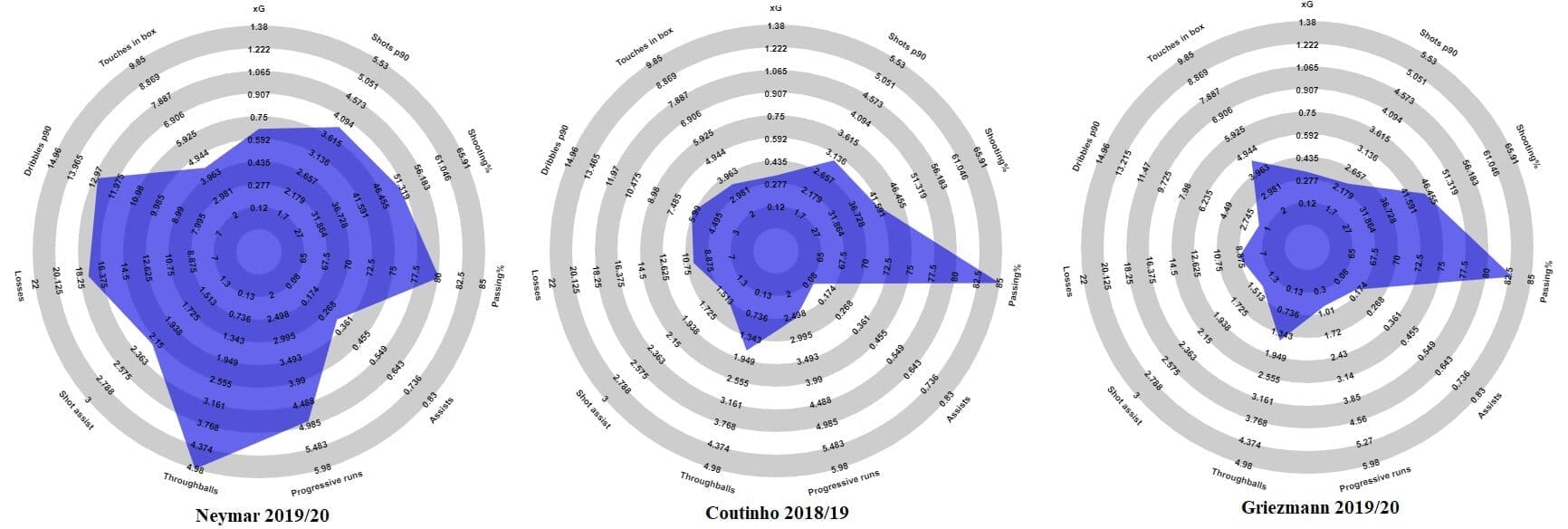
The only thing the latter two players have in their favour is the overall passing accuracy but at the end of the day, they can’t measure up to Neymar nor do they even come close to him. The difference is quite staggering, to say the least.
Even Coutinho’s shooting, which was arguably his biggest weapon at Barcelona, couldn’t edge out Neymar’s in a significant way. But looking at their respective roles, they do offer similar things and have similar strengths, especially the two Brazilians: both are exceptional on the ball with almost flawless technical abilities, have a killer pass, great dribbling skills and an eye for the final product in terms of goals and assist.
The only difference is the fact that Neymar does all of that slightly or much better than his Brazilian compatriot. Even though Griezmann’s and Coutinho’s radars look similar, the Frenchman is the one out of place here as he was never supposed to be put in that role nor does his overall style fit it.
Obviously, in terms of statistics, there’s a clear winner in this fight, as unfair as the comparison itself might be. But for all their similarities, the three are essentially different players and will behave differently on the pitch.
While all three love the central areas and will spend the majority of their time in their respective half-space, Neymar is the most aggressive of the three and the one with both the pace and the dribbling to excel as Barcelona’s winger. The following graphs of all three’s 1v1 dribbling duels and shot locations shed some light on that thesis.
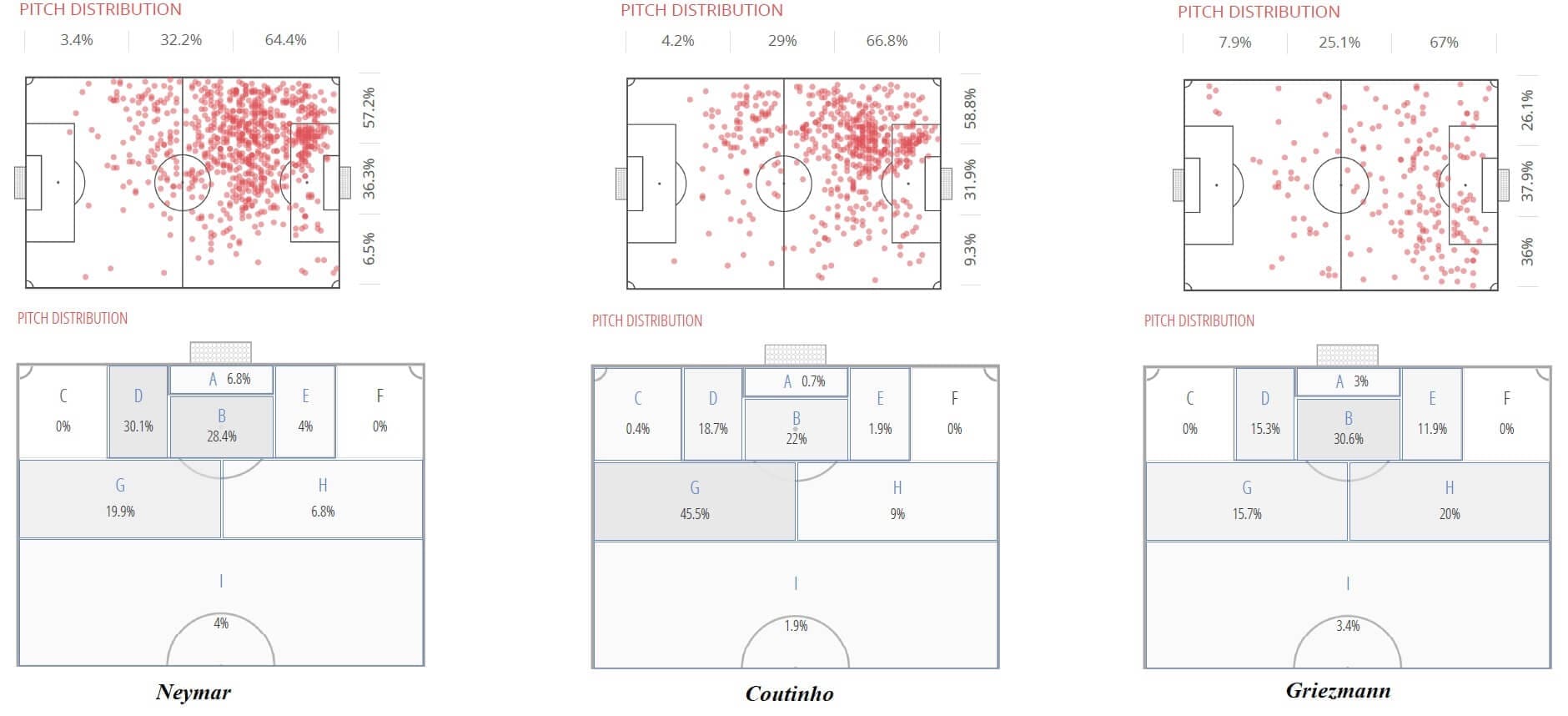
Neymar is the only one that engages in the final third and is by far the one with the highest dribbles per 90 value out of the three of them with 13.22 compared to Coutinho’s 6.1 and Griezmann’s 1.85.
Not only that but nearly 70% of his shots take place inside the box with Griezmann tallying just over 60% and Coutinho lagging behind heavily with his preference of the left half-space. This tells us that PSG’s talisman is the most aggressive of the three and will venture into the box the most to either take defenders on and/ or shoot on goal.
But how would his presence impact other players on the pitch and other Barcelona tactics?
The dominant winger
By now it’s not a big secret that Neymar’s departure freed Jordi Alba and enabled him to express himself as Barcelona’s biggest goal threat next to the ever-present Messi and Suárez right after the Brazilian’s departure.
The now-famous Messi-Alba connection maybe would’ve never been invented had Neymar not departed when he did, leaving the Spaniard in sole control of the whole left flank. This very much shaped Barcelona’s overall tactics as well.
But mostly it affected Alba’s contribution to the final product at the club. Notice in the graph below how his attacking influence increased with time or rather, it was rather low during the years Neymar was at the club and then it received a significant boost once the Brazilian left for Paris Saint-Germain in 2017.
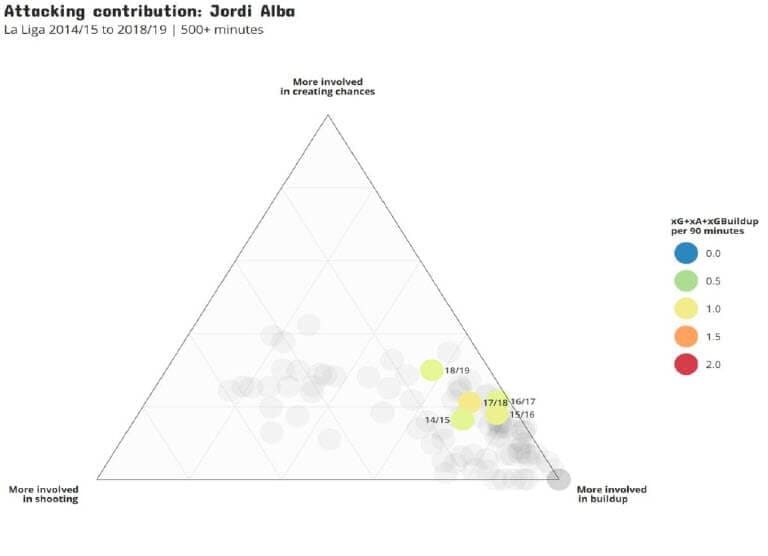
The numbers also fully support this thesis when we delve more into them. Jordi Alba from 2016/17 with Neymar had an xG value of only 0.36 while his xA stood at 3.68. And what happened when Neymar left? Rebirth.
In 2018/19 Alba’s numbers skyrocketed and from 0.36, his xG increased immensely to 2.82 while his xA values almost doubled as well, going from 3.68 to 6.69. That change was huge and crucial for both the player and the club. The Spaniard has become Messi’s favourite provider and the famous link has been established despite Alba dipping in form since then.
But what does Neymar’s potential return mean for that as a whole? The Brazilian is certain to limit Alba at least partially since he will represent a more dominant figure at that left-wing. With Coutinho or even Griezmann, it was easier. They would constantly cut inside to their half-space, leaving Alba to overlap regularly.
And the old Neymar had that tendency of sticking to his position and standing firm in the wider areas. But his tactics have evolved since then. He has transitioned from a forward to a playmaker and this role takes him away from the wings and often puts him into deeper and more central areas of the pitch, as we’ve noted earlier in this scout report.
Note in the example below how that looked like at PSG and how it might look at Barcelona as well. Despite him having a more advanced and wider role, Neymar is still positioned deeper and lets his full-back overlap. Not only that, but the Brazilian is the one who could very well be the one sending Alba bursting into the box with his passing.
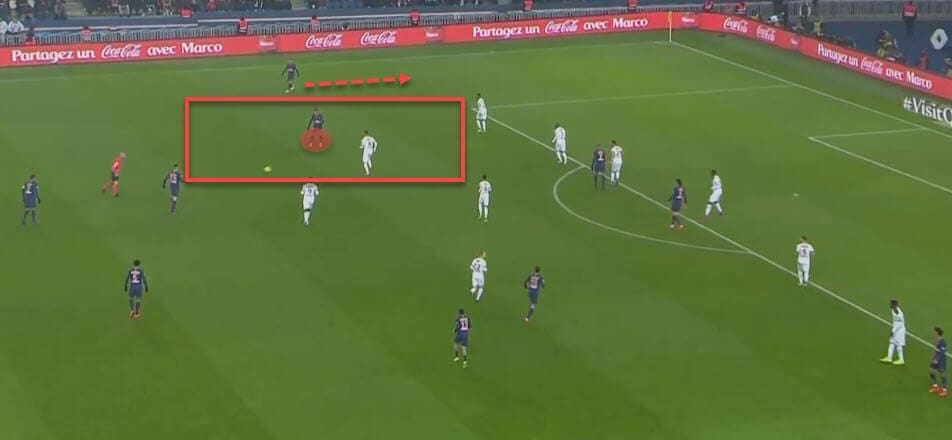
But even if he does go further up the pitch, which is unavoidable since he is a forward after all, Neymar is no longer that same player who will hug the touchline constantly and claim it only for himself.
Instead of going all the way into the wider areas, Neymar can stay in his half-space to accommodate his full-back more, just like Coutinho did before him. If Quique Setien decides to do the same with his new Brazilian as well, this could not only let Alba do his usual magic but would also give him an even better playmaker to link up with during his constant overlaps and bombardment of the opposition’s box.
Overall, it looks like Neymar has developed his game enough to fit alongside Alba rather than limiting him and his potential output for the team. This is the crucial first step towards incorporating the Brazilian back into the team.
Messi 2.0
Messi is unique in everything he does on the pitch but if there’s one player who comes close to replicating his effect then that’s Neymar. The Brazilian was always touted as the natural heir to his former teammate and while he is also not the youngest of players anymore, the Brazilian still fits the mould perfectly.
When it comes to like-for-like replacements, Barcelona won’t get a better match than their former starlet. Let’s first compare their respective profiles through stats, just the way we’ve done for Coutinho and Griezmann, using the same metrics and the same maximum values across the top five leagues in 2019/20.
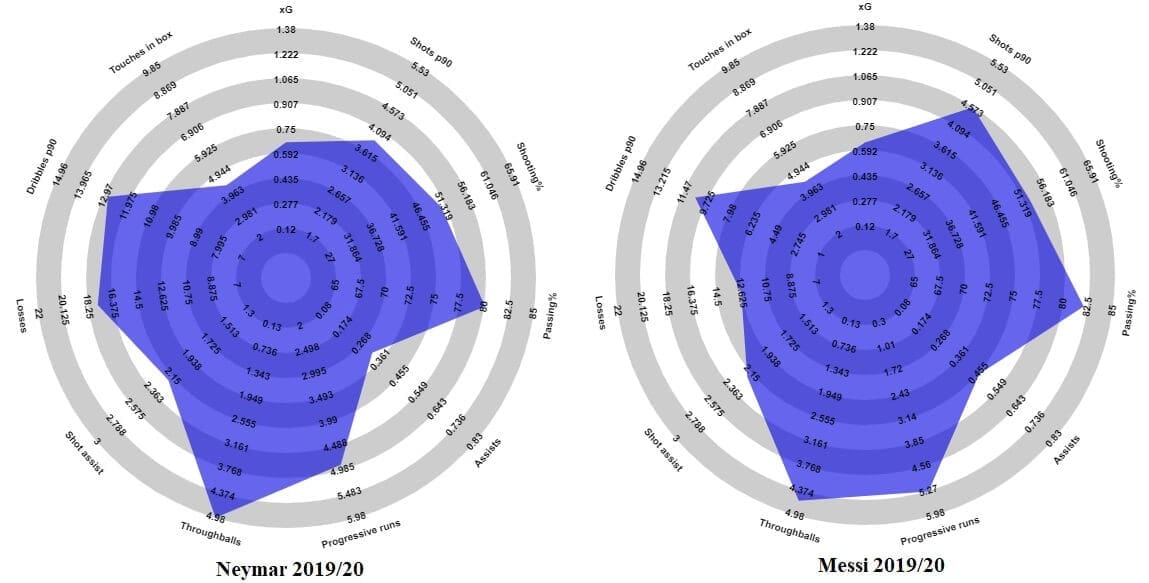
Immediately we can see that their profiles are almost a perfect match with Neymar mimicking Messi’s output in the ongoing campaign and the two having marginal differences in some of the metrics.
The situation is fairly similar when it comes to their movement on the pitch and the similarity in stats would also suggest there are certain overlaps in their roles as well. Both players are the respective playmakers for their team, often being the ones to progress the ball via their dribbling, passing or marauding runs and are also there for the final product in terms of providing both goals and assists.
The heatmaps will tell us a similar story as well. Of course, Messi’s reach and area of effect are still slightly bigger than Neymar’s and he tends to cover more ground inside the box as well as in the deeper and more central areas. In essence, their movement and positioning are quite similar but only happen on the opposite sides of the pitch.
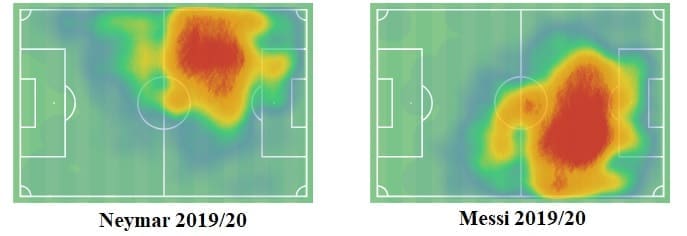
So is this good news for Barcelona or a potential issue? It’s a little bit of both, to be honest. Having one Messi on the pitch is deadly enough but imagine having two of them. That’s essentially what Neymar would bring to the table. He can share the load and take some burden off of Messi’s back and do it admirably well, without Barcelona having to dip in quality too much, if at all.
One of the aspects Neymar has improved in the most is carrying the ball into the advanced zones and setting up play for his teammates. We’ve seen as much in the initial graph at the beginning of this tactical analysis when we compared him to his former Barcelona self.
The Brazilian can use his incredible technical and dribbling abilities to carry the ball from the deep and into the final third and then deploy one of his deadly through ball that penetrates the defensive lines with ease. Let’s observe such an action in the example below.
Neymar receives the ball in his half, only to beat his marker, burst into space behind and then deploy a pinpoint accurate pass into the feet of Edinson Cavani. This is not only elite ball progression but also a trait of a deadly winger who can attack the area with pace, which is something Barcelona are currently lacking and something neither Coutinho nor Griezmann can give them.
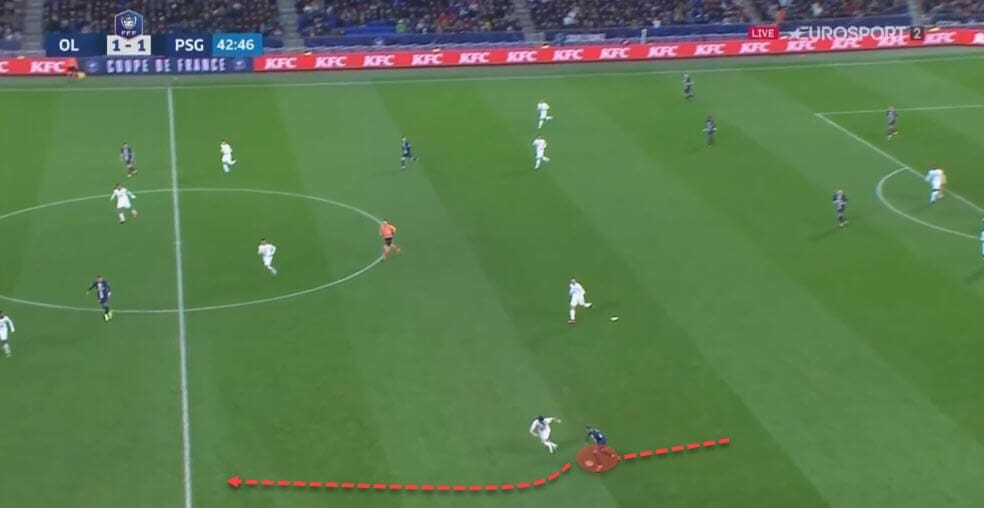
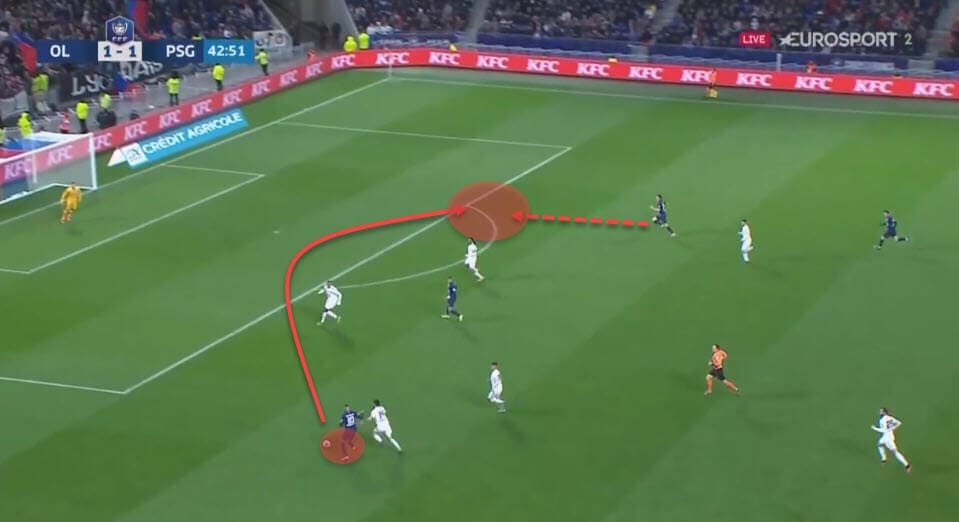
Note that is a role Messi regularly undertakes in Barcelona’s tactics and up until the arrival of Frenkie de Jong, the Argentine was practically the only player in the squad capable of doing it at such a high level.
So with the incorporation of Neymar, the Catalans would theoretically have two extreme facilitators – one on the left and one on the right – and two players capable of singlehandedly changing the outcome of any game. But can they coexist within the same team in their current roles? It’s rather difficult to answer that question.
Coutinho’s profile is fairly similar to Neymar’s in many regards, only the latter player is an upgraded version in almost every single regard. Still, the former Liverpool star struggled when he didn’t have access to the no.10 role and his preferred movement around the zone 14 was limited due to Messi’s presence.
But a big part of his struggle was also his own making and he declined drastically upon arriving in Catalonia. Neymar’s sheer quality means he’d be an upgrade on his compatriot. What Barcelona have to realise, however, is that Neymar is not the same player he used to be back in the day and they wouldn’t be getting an out-and-out winger anymore.
With both Messi and Neymar occupying the central zones, the Catalans would have to get their width exclusively from the full-backs. Of course, we’ve seen that the Brazilian is still capable of keeping his width and advancing through the flanks but the evolution of his game demands a capable overlap once he does vacate his wing.
But when we take a look at their full-backs, only Jordi Alba stands out among the other full-backs in the top five leagues when we measure the key passes and xA (expected assists) per 90 minutes.
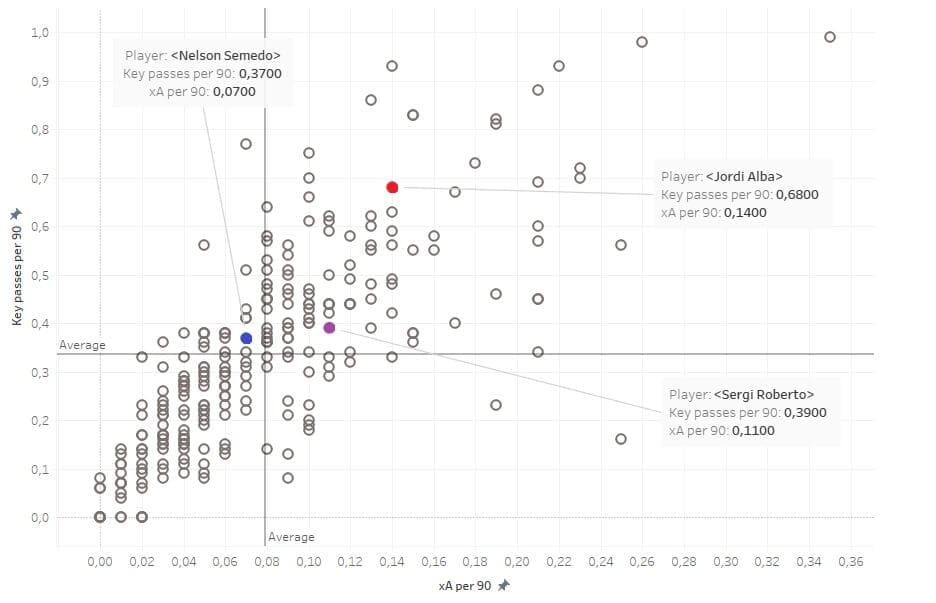
Of course, when it comes to Neymar, only Alba matters since he is the one who’ll be tasked with overlapping on the left side and it seems that the Spaniard can still hold his own despite a slight dip in form as of late.
With 0.68 key passes and 0.14 xA per 90, Alba is still well above average in both metrics and could still be a good choice for Barcelona for at least a couple more years.
But that’s only the left side of the pitch, which is generally far more dangerous and active in the attacking phase and Neymar’s arrival would only enhance that contrast between the flanks and wouldn’t do much to solve the bigger issue that is the right-wing.
At the end of the day, however, that is not the purpose of his signing and Barcelona will have to look elsewhere for a solution to that particular problem.
Final remarks
We don’t know how the partnership between Messi and Neymar would look like today and the two players being so similar in profile might pose a problem. But Barcelona need someone to successfully take some burden off of Messi’s back and with Neymar’s quality and ability to both be a facilitator and an aggressive winger, saying he wouldn’t solve at least some of their issues is a stretch.
He may not be a traditional width provider nor a player who exclusively attacks space but he is still one of the best players on the planet and as close as Barcelona can get to a Messi-esque individual on the pitch.
Whether they truly do make it work, if the transfer happens, remains to be seen and it will ultimately fall on Setien’s plate to somehow squeeze the Brazilian into his tactics.

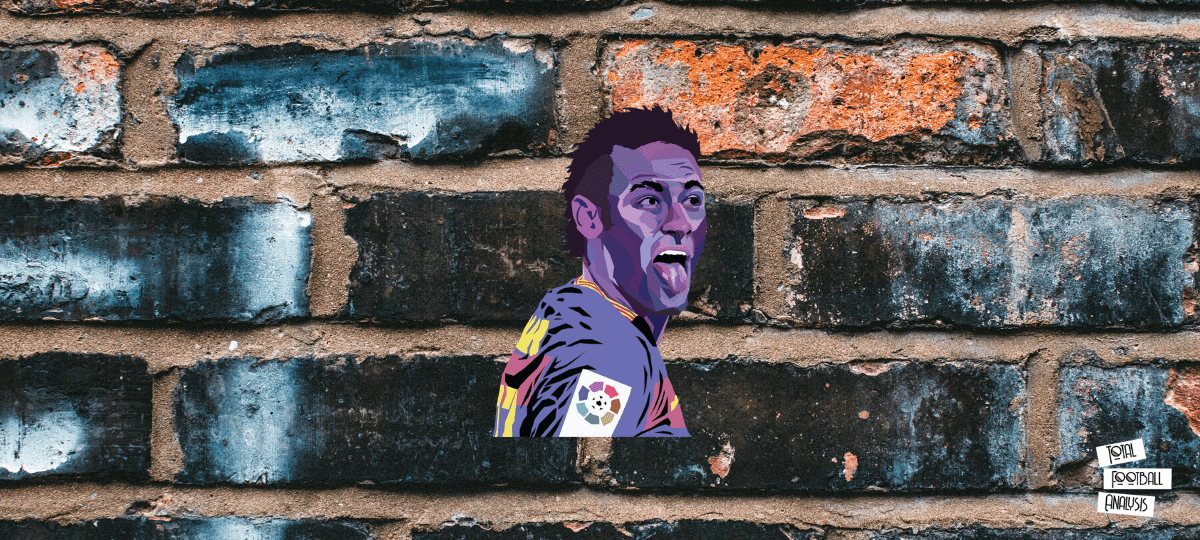




Comments